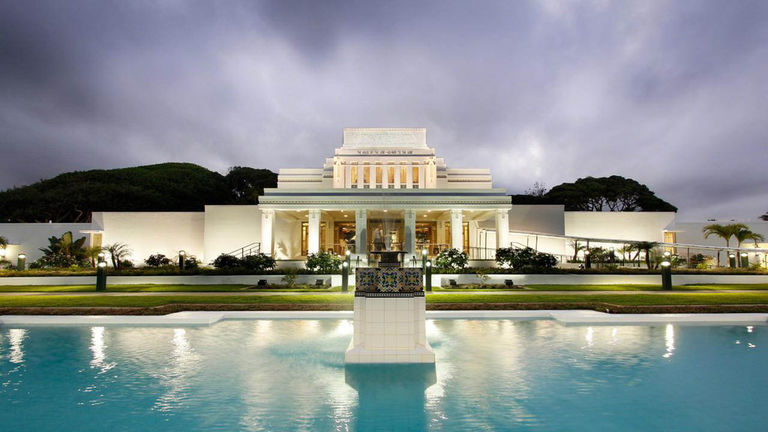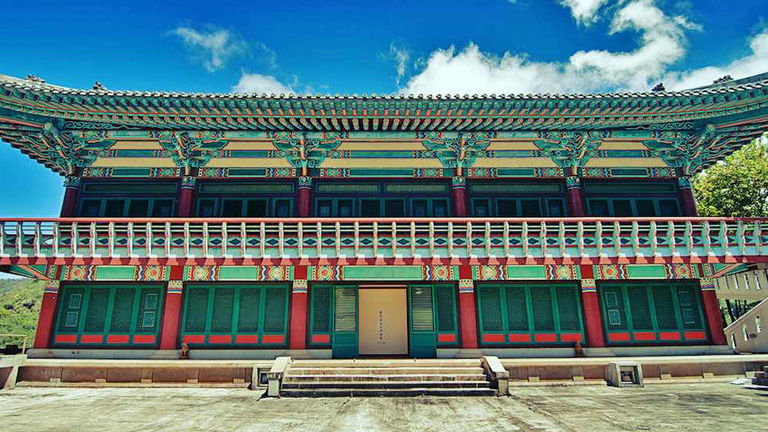For centuries, Hawaii’s natural beauty has stirred up deep thoughts and powerful feelings in its residents and visitors alike. The ancient Hawaiians responded by building heiau (outdoor stone temples) for prayer and safety. In more recent centuries, island residents have continued to create inspirational structures — from Buddhist temples to a Hindu monastery, a Mormon house of worship and more — in compelling landscapes, symbolizing their wide-ranging religious and cultural traditions.
The following five Hawaii temples present a lovely respite from active vacations in the tropics, whether clients want to learn about the past, admire the architecture or simply meditate in peaceful surroundings.
Byodo-In Temple, Oahu
Presided over by the 2,000-foot-tall Koolau mountains, this Buddhist temple on Oahu’s windward side replicates a revered temple in Japan. Made entirely without nails, it opened in 1968, timed with the 100th anniversary of the first Japanese immigrants to Hawaii.
Gardens, waterfalls, koi ponds, small bridges, tropical blossoms and wild peacocks grace the grounds, which have served as a sensational backdrop for television shows such as “Hawaii Five-0.” Before entering Byodo-In Temple, clients can ring the 5-foot-tall, 3-ton brass bell for good luck. Inside, an 18-foot-tall, gold leaf-covered Buddha awaits guests, who can light incense and take a few moments to relax and reflect.
The temple grounds are open to visitors daily from 8:30 a.m. to 5 p.m.; general admission is $5 ($4 for seniors and $2 for children). Guided tours can also be arranged in advance.
Hindu Monastery, Kauai
Founded in 1970, this 363-acre monastery on Kauai’s east side looks and feels like a slice of nirvana. Here, amid waterfalls, rivers, rainbows and flowers, 18 monks from six countries live, meditate and serve. At the heart of the estate stands a tranquil temple and an awe-inspiring, 12-foot-tall black granite statue of a Hindu god. Nearby, workers are constructing a second, larger temple out of hand-carved granite from India.
 The location of Kauai's Hindu Monastery makes the most of nature's wonders.
The location of Kauai's Hindu Monastery makes the most of nature's wonders.
Credit: 2019 Kauai's Hindu MonasteryRather than promoting itself as a tourist stop, the monastery welcomes modestly clad guests who take spiritual matters seriously. The front outdoor grounds are open to the public from 9 a.m. to noon, with a self-guided tour available. To enter the temple building, visitors must make a reservation in advance, for a 9 a.m. service or a brief entry at 11 a.m.
Laie Hawaii Temple, Oahu
In ancient times, Laie was considered a place of refuge for fugitives and transgressors. People of Mormon faith still think of the tidy North Shore Oahu town as a haven, and they built a magnificent temple there in 1919 to demonstrate their devotion. Today, as visitors drive along Kamehameha Highway, they get a dramatic view of the gleaming white shrine.
 Laie's Mormon Temple stands next to Brigham Young University-Hawaii and the Polynesian Cultural Center.
Laie's Mormon Temple stands next to Brigham Young University-Hawaii and the Polynesian Cultural Center.
Credit: 2019 www.ldschurg.orgWhile non-Mormons can’t go inside the temple — the first of its kind outside of the U.S. mainland — they can join public tours of the grounds, notable for its gardens, palm trees and reflecting pools. They can also spend time in the visitor center to learn more about the religion and its roots in Hawaii.
Mu Ryang Sa Temple, Oahu
Embraced by steep ridges above Honolulu, this 1.5-acre compound is the largest Korean Buddhist temple outside of Korea. Home to a group of monks who live, chant, meditate and study, it provides an idyllic alternative to the bustle of the city and a sweet spot to take a breather.
 Mu Ryang Sa Temple provides a quiet sanctuary above Honolulu.
Mu Ryang Sa Temple provides a quiet sanctuary above Honolulu.
Credit: 2019 Mu Ryang Sa TempleA stroll around the spread leads to eye-catching features such as a staircase where 1,080 miniature disciple figures watch over the landscape; the Peace Pagoda, a replica of a significant pagoda in South Korea; a bell tower with a colorfully painted roof; and the five-story main structure, completed in 2005. Mu Ryang Sa Temple is open daily for self-guided, contemplative walks.
Editor's Note: This story, originally published Sept. 11, 2019, was updated Dec. 15, 2023.